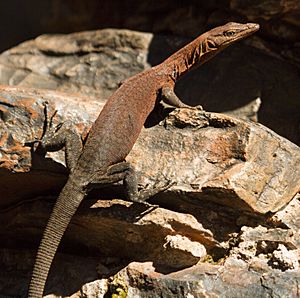Southern Pilbara rock goanna facts for kids
Quick facts for kids Southern Pilbara rock goanna |
|
|---|---|
 |
|
| Conservation status | |
| Scientific classification | |
| Genus: |
Varanus
|
| Species: |
hamersleyensis
|
The Southern Pilbara rock goanna (Varanus hamersleyensis) is a small lizard. It is also called the Hamersley Range rock monitor. This goanna belongs to the Varanidae family, which includes monitor lizards.
Contents
What is the Southern Pilbara Rock Goanna?
The Southern Pilbara rock goanna is a type of monitor lizard. It looks a bit like another species, Varanus glauerti, but it's usually darker. It has cool whitish spots near its eyes.
How Big Are They?
This goanna has a slender body. It's not very big. From its snout (nose) to its vent (where its tail starts), it's less than 160 millimeters long. That's about 6.3 inches. Its tail can be more than twice as long as its body!
Where Does the Southern Pilbara Rock Goanna Live?
This special goanna lives only in the Hamersley Range in Western Australia. It likes places that are rocky and steep.
What Kind of Habitat Do They Prefer?
You can find them in areas with different plants. They often live near eucalyptus trees and clumps of spiky spinifex grass. Their homes are usually on ironstone formations. These areas have deep gorges and steep cliff faces. Each goanna tends to stay in its own local rocky home.
How Was This Species Discovered?
Scientists first described the Southern Pilbara rock goanna in 2014. They studied rock monitors from the Pilbara region in north-west Australia. They noticed differences in color and DNA. These differences showed that the goannas in the southern Pilbara were a new species.
Naming the New Species
The first official specimen, called a "holotype," was found in the Hamersley Range in 2003. It was first thought to be a different species. But scientists compared it to other goannas. They then realized it was unique in their 2014 study. The name hamersleyensis comes from the Hamersley Range. This is the area where all known specimens have been found.


